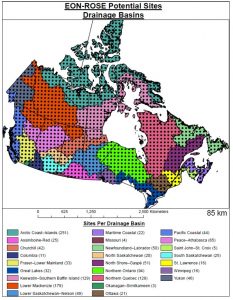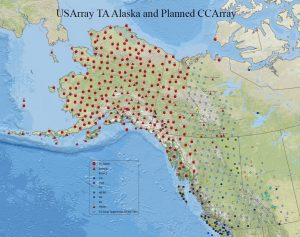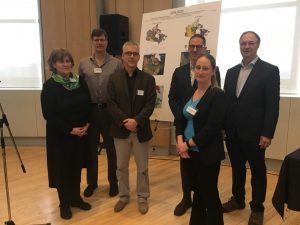
Comment l’EON-ROSE pourrait-il intégrer les sciences du climat et de la Terre?
– Par K.J.E., Boggs1, P., Audet2, D.W., Eaton3, M. Fayek4, J.T., Freymueller5, R.D., Hyndman6, T. James6, P.J., Kushner7, P. Myers8, M.G., Sideris3, P. Sullivan9, and M. Ulmi6 –
Partout dans le monde, les changements climatiques, la croissance démographique, les dangers naturels et la nécessité d’assurer la durabilité à long terme des ressources (y compris les matériaux, l’énergie et les aliments) exigent une nouvelle approche des sciences du système terrestre. L’EON-ROSE (Earth-System Observing Network – Réseau d’observation du système terrestre) est une initiative représentant un modèle parmi d’autres, afin que la science du système terrestre vienne en aide au développement durable de notre planète. Ce partenariat de recherche pancanadienne, qui vise à examiner de façon holistique les systèmes de la Terre — de la magnétosphère (la région de l’espace qui contient le champ magnétique terrestre) au tréfonds du manteau (la couche située entre la croûte terrestre et son noyau liquide en fusion) — est actuellement à la recherche de collaborateurs. Les groupes qui se concentrent sur les applications de l’EON-ROSE relativement à la physique spatiale, ainsi qu’aux sciences océanographiques, atmosphériques, hydrologiques, cryosphériques et écosystémiques, et à la modélisation numérique (y compris la prévision du temps, le système terrestre, la surface terrestre et les bassins versants) sont particulièrement bienvenus. L’objectif ultime est de fournir des capacités nationales de surveillance en temps réel qui peuvent soutenir des outils améliorés destinés à la gestion des risques, aux stratégies d’adaptation aux changements climatiques, à la surveillance des écosystèmes, aux systèmes d’alerte de tremblements de terre et d’autres catastrophes, et bien plus encore.

Across the globe, climate change, population growth, natural hazards and the need for long term sustainability of resource supply (including materials, energy and food) demand new approaches to Earth System Sciences. EON-ROSE (Earth-System Observing Network – Réseau d’Observation du Système terrestrE) is an initiative representing one possible model for driving Earth System Science to support sustainable development for our planet. This pan-Canadian research collaboration, which aims to holistically examine Earth systems from the magnetosphere (the region of space that contains the earth’s magnetic field) deep into the mantle (the layer between the earth’s crust and its liquid molten core), is currently seeking additional collaborators. Groups with a focus on applications of EON-ROSE to space physics, oceanographic, atmospheric, hydrological, cryospheric and ecosystem sciences and numerical modeling including weather, Earth system, land-surface and watershed, are particularly welcome. The ultimate goal is to provide national real-time monitoring capabilities that can support improved tools for risk management, climate change adaptation strategies, ecosystem monitoring, earthquake and other disaster warning systems, and much more.
EON-ROSE seeks to be a combined effort of Canadian universities; federal, provincial and territorial government agencies; industry; and international collaborators. Its overarching vision is to deploy a network of telemetered observatories to monitor solid-Earth, environmental and atmospheric processes (Figure 1). The Canadian Cordillera Array (CCArray) is the initial phase of EON-ROSE, extending across the Cordillera from the Beaufort Sea to the U.S. border (Figure 2). A key element of the proposed EON-ROSE and CCArray initiatives involves integrating oceanography, atmospheric sciences, space physics, critical zone (extending from the vegetation canopy through the land surface to the underlying aquifer) science with the solid Earth geosciences.
At the first Symposium on EON-ROSE, which was held in Ottawa, February 21-23, 2018, the focus was on national applications related to (i) Solid Earth and Resources, (ii) Fluid Earth, Critical Zone and Environmental Monitoring, and (iii) Natural Hazards and Information Synthesis. This symposium started with a presentation by Daniel Lebel, the Director General of the Geological Survey of Canada, and an overview of the US EarthScope program by Jeff Freymueller, the Director of the EarthScope National Office in Fairbanks, Alaska (Figure 3). EarthScope deployed a coordinated west-to-east array of seismometers, geodetic, and other geophysical instruments across the continental US and into Alaska, enabling a wide range of work across the seismological and other geophysical sciences including imaging of discontinuities deep into the Earth’s mantle. The scale (and scope!) of EarthScope attracted broad attention, for example being identified as the top science experiment of the decade by Popular Science in January 2011.

We note the engagement of the CMOS community in this initiative. During the “Fluid Earth, Critical Zone and Environmental Monitoring” session, Paul Kushner’s (University of Toronto and CMOS President) presentation entitled “How can EON-ROSE Integrate Climate Science and Earth Science” discussed the advantage of using carefully designed and integrated observing networks capturing atmosphere/ocean and geophysical could be coordinated through EON-ROSE. Paul Myers (University of Alberta; former CMOS President) provided slides (presented by Kushner) discussing measurements and modelling of ocean circulation and freshwater at high-latitudes. Pamela Sullivan (University of Kansas) reviewed opportunities for developing Critical Zone Observatories in Canada to enhance process understanding of the critical zone, which is the vegetation canopy-to-aquifer earth system zone that supports the terrestrial biosphere. In the subsequent discussion, Jeff Freymueller commented on how important it is to use geophysical networks to monitor environmental and geophysical processes. Calvin Klatt (Director General of the Canadian Geodetic Survey (CGS)) presented on solid and fluid Earth applications by the CGS. Thomas James (NRCan) outlined how glacial isostatic adjustment (GIA) is critical in Canada for monitoring sea level change, seismic activity and hydrological changes across Canada. Gilbert Brunet (Director, Meteorological Research Division, Meteorological Service of Canada/Environment and Climate Change Canada) also provided slides outlining potential applications to numerical weather modeling for the EON-ROSE and CCArray initiatives.
Further details about these initiatives are available at www.ccarray.org and in Boggs et al. (2018). We welcome potential collaborators, questions or suggestions. Please contact any of the authors of this document and refer to the website – ccarray.org – for more information.

REFERENCE
Boggs, K.J.E., Aster, R.C., Audet, P., Brunet, G., Clowes, R.M., de Groot-Hedlin, C.D., Donovan, E., Eaton, D.W., Elliott, J., Freymueller, J.T., Hedlin, M.A.H., Hyndman, R.D., James, T., Kushner, P.J., Morell, K.D., Rowe, C.D., Schutt, D.L., Sideris, M.G., Ulmi, M., Vernon, F.L., and West, N., in press. EON-ROSE and the Canadian Cordillera Array – Building Bridges to Span Earth System Science in Canada. Geoscience Canada.
AUTHOR AFFILIATIONS
1Université Mount Royal, 23Université de Calgary, 4Université du Manitoba, 5University of Alaska Fairbanks, directeur d’EarthScope National Office 6Commission géologique du Canada, RNCan, 7Université de Toronto, président de la SCMO, 8Université de l’Alberta, ex-président de la SCMO, 9University of Kansas
« On ne peut résoudre un problème important avec le même niveau de pensée que celle qui l’a créé. » (Albert Einstein)
Canadian Cordillera Array, CCArray, EON-ROSE, Katherine Boggs